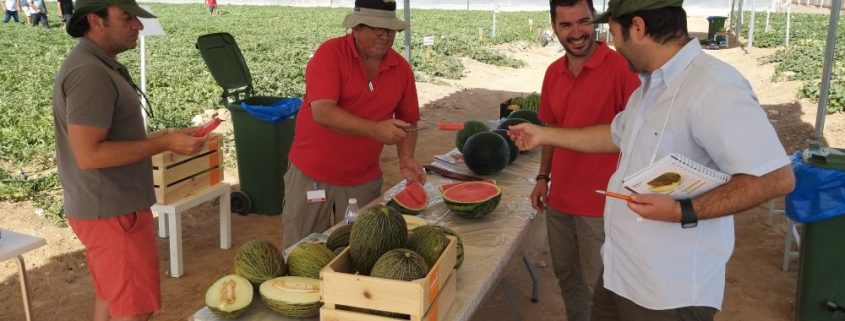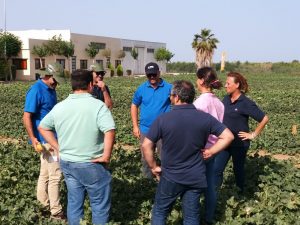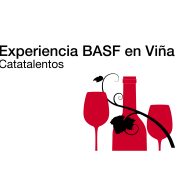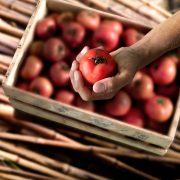How will watermelons and melons be in the coming years
Different colors, textures, flavors, forms and ways of consumption. This is what the melon and watermelon consumer will look for in a few years, and BASF Vegetable Seeds is already working on it, with new proposals and aware that aspects such as health and sustainability must fully enter the priority pack of any section varietal
By Marga López, agri-food journalist.
A few days ago Nunhems®, a subsidiary of horticultural seeds of BASF Vegetable Seeds, showed in its Business Event For Experts in Cartagena, its proposals in melon and watermelon, and did so with important developments, such as Colosseum F1, a Piel de Sapo with intermediate resistance to the New Delhi virus, or the extension of the Galia, Galkia line. If we look at the watermelon segment, Nunhems®, where it is indisputably an undisputed leader, has a complete varietal portfolio, from striped and black watermelons without high quality seeds, mini, midi and unipersonal calibers and watermelons for processing, not forgetting those of yellow meat.
All this is what the attendees of this event could see and taste, but in eComercio Agrario, we wanted to deepen in other aspects, not only varietal, but future trends in melon and watermelon, because it is clear that the seed houses They have a lot to say and do to boost their production, their consumption, and the profitability of the entire value chain.
To this end, we have met with members of the Nunhems® team to whom we have raised the following questions:
Unlike watermelon, melon is in a serious crisis of consumption, perhaps due to the lack of flavor. In recent years the seed houses have worked on resistance and productivity, but the taste has been left out, to what degree do we find these three parameters (resistance-productivity-flavor) in your melon catalog?
BASF Vegetable Seeds has always had the flavor in mind as an hallmark and that is why the Nunhems® brand is recognized, under which we operate in the market. In all the types in which we work we have created flavor lines such as GALKIA with which we have returned to Galia consumers the possibility of eating a traditional melon with a reasonable post-harvest, with the varieties Kirene F1, Kinder F1, Kinium F1 In Charentais, Khorum F1, Arum F1 and Gustabel F1 are recognized and appreciated for their extraordinary taste and external presentation. In addition, Arum F1 has a high resistance to powdery mildew in the late cycles where the strongest attacks of this disease occur. In Piel de Sapo, our latest market introduction Colosseum F1 * brings together resistance in the same variety (the first variety with intermediate resistance to ToLCNDV), high yields and an excellent flavor for the early cycles. NUN 68557 MEM F1 * and NUN 68307 MEM F1 * give continuity in La Mancha for the medium cycle and Toledano F1 * ends in La Mancha with high productions and resistance to aphid and powdery mildew.
That is, we are working on new types of melon that respond to the needs of new consumers, increasingly demanding in flavor and new formats. You have to reinvent the world of melon by providing different colors, textures, flavors, forms and ways of consumption, as is happening with other products.
Another aspect that worries farmers is the costs. In the best varieties of melon, productivity falls, so the costs soar, while the consumer is not willing to pay that extra, how is Nunhems® working in this line?
We are aware of this and productivity is a selection parameter in the same way as taste and resistance. Our latest introductions of melon in the market, Colosseum F1 * and Toledano F1 * show this.
In watermelon, you have a complete catalog of successful varieties. As great connoisseurs of this category, where does the consumer point, what do you think will be the typologies that will predominate in the linear ones in the coming years and why, what value do they contribute?
In our case, innovation in watermelon involves covering the expectations of both the current consumer and the consumer of the future. We have to make eating a watermelon a “sensory experience”, where you can enjoy flavors, textures, aromas. In short, it has to be a “healthy pleasure.”
With regard to the characteristics of the fruit, at BASF Vegetable Seeds we are working mainly to guarantee a more crunchy and compact texture, without harming the traditional flavor and color, which facilitates the different types of processing of the fruit and the different types of presentation; to rooms, halves, tubs, fingers, etc. Ensuring that the consumption of watermelon is a “pleasant and healthy” experience.
In short, for BASF Vegetable Seeds, and in the opinion of Pere Montón, Account Manager
Watermelon in this company, the main challenges that watermelon must face are related to three fundamental aspects: TASTE, HEALTH AND SUSTAINABILITY.
“THE FLAVOR, is something non-negotiable, we have come here thanks to him and we will continue betting on it; HEALTH, is one of the aspects that the current consumer is valuing the most, and that is that prevention policies are currently more important than curative ones. Consumers want to take care of their health in an active and conscious way and for this the watermelon is the ideal fruit, because of its high content in lycopene, citrulline and other antioxidants make this fruit a source of health, moisturizing and balanced, ”he concludes Pere Montón.
















